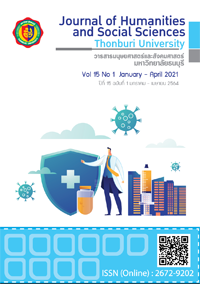The Facts of Investor Behavior in Long Term Equity Funds of Thailand Investor
Keywords:
Long Term Equity Fund, Total Expense Ratio, December Effect, Bank related Funds, Non-Bank related FundsAbstract
The objective of this research is to present the facts of investment behavior in Long Term Equity Funds among investors in Thailand. The focus is on Long Term Equity Funds related to Bank and Non-Bank related Funds. Data of 79 funds between the year 2004 and 2019. Do analysis Random-effects panel data model found that (1) There are few investors who make rational decisions based on traditional economics. (2) Factors from being a commercial bank, Number of commercial bank branches and size of the fund significantly affect the changing trading volume of banks. (3) The net asset value per unit and the performance measure have a significant affect the changing trading volume. It shows that investors have a contrarian investment strategy. (4) Low fund management fees and high fund management fees that yield more returns will have a significant affect the changing trading volume. (5) The December Effect still appears in Long Term Equity Funds.
References
ชัยพร น้อมพิทักษ์เจริญ. (2561). พฤติกรรมของคนลดหย่อนภาษี. สืบค้นเมื่อ 20 ธันวาคม 2562, จาก http://www.bangkokbi znews.com/blog/detail/645804.
ตลาดหลักทรัพย์แห่งประเทศไทย. (2558). LTFคืออะไร. สืบค้นเมื่อ 20 ธันวาคม 2562, จาก http://www.set.or.th/education/ th/begin/mutualfund_content08.pdf.
บุณณชนก เดชเพ็ชร์ และ ธนโชติ บุญวรโชติ. (2559). การเปรียบเทียบผลการดำเนินงานของกองทุนรวมที่ลงทุนในหุ้นที่บริหารโดยบริษัทหลักทรัพย์จัดการกองทุนที่ถือหุ้นใหญ่และไม่ถือหุ้นใหญ่โดยธนาคารพาณิชย์. วารสารวิจัยเพื่อพัฒนาชุมชน (มนุษย์ศาสตร์และสังคมศาสตร์). 9(2): 106-144.
ปรีชา มานพ. (2559). กองทุนรวมในประเทศไทย: หลักฐานใหม่. วิทยาศาสตร์มหาบัณฑิต, มหาวิทยาลัยธรรมศาสตร์.
ภูธร สุขวณิช. (2558). กระแสเงินทุนและพฤติกรรมการจัดสรรสินทรัพย์ของนักลงทุนกองทุนรวม. วิทยาศาสตร์มหาบัณฑิต, จุฬาลงกรณ์มหาวิทยาลัย.
ลงทุนศาสตร์. (2560). 10 ขั้นตอนการเลือกกองทุนอย่างมืออาชีพ. สืบค้นเมื่อ 27 สิงหาคม 2562, จาก https://aommoney.com/ tories/aommoney-guru-column/10-ขั้นตอนการเลือกกองทุนอย่างมืออาชีพ/18800#kegxhsij 74.
Borenstein, M., Hedges, L., & Rothstein, H. (2007). Meta-Analysis Fixed effect vs. random effects. Retrieved August 26, 2020, from www.meta-analysis.com/downloads/M-a_f_e_v_r_e_sv.pdf.
Frye, M. B. (2001). The performance of bank-managed mutual funds. Journal of Financial Research. 24(3): 419–442. https://doi.org/10.1111/j.1475-6803.2001.tb00778.x
Gottesman, A. A., & Morey, M. R. (2007). Predicting Emerging Market Mutual Fund Performance. SSRN Electronic Journal. https://doi.org/10.2139/ssrn.897184
Hao, Q., & Yan, X. (2012). The performance of investment bank-affiliated mutual funds: Conflicts of interest or informational advantage?. Journal of Financial and Quantitative Analysis. 47(3): 537–565.
Kahneman, D. (2003). Maps of bounded rationality: Psychology for behavioral economics. The American Economic Review. 93: 1449-1475.
Lumencandela. (2020). Rational and Nonrational Decision Making. Retrieved August 26, 2020, from https://courses. lumenlearning.com/boundless-management/chapter/rational-and-nonrational-decisi on-making/.
Morningstar. (2019). Retrieved August 13, 2019, from http://tools.morningstarthailand.com/th/fundquickrank/default. aspx?Site=th&LanguageId=th-TH.
Patel, J. B. (2015). The January Effect Anomaly Reexamined in Stock Returns. Journal of Applied Business Research (JABR). 32(1): 317-324.
University Herald. (2020). The Difference Between Traditional Finance and Behavioral Finance. Retrieved August 26, 2020, from https://www.universityherald.com/articles/77186/20200203/the-differenc e-between-traditional-finance-and-behavioral-finance.htm.
Wattanatorn, W., Padungsaksawasdi, C., Chunhachinda, P., & Nathaphan, S. (2015). Liquidity Timing in the Higher Moment Framework: Evidence from Bank Affiliated Fund. SSRN Electronic Journal. https://doi.org/ 10.2139/ssrn.2826362.
Translated Thai References
Detpech, Bunachanok. and Boonvorachote, Tanachote. (2016). Equity Fund Performance Comparison between Bank Affiliate and Non-Bank AffiliateSubsidiary Mutual Funds. Journal of Community Development Research (Humanities and Social Sciences). 9(2): 106-144. (in Thai)
Investment science. (2017). 10 steps to choose a professional fund. Retrieved December 27, 2019, from https://aom money.com/stories/aommoney-guru-column/10-ขั้นตอนการเลือกกองทุนอย่างมืออาชีพ/18800#kegxhsij74. (in Thai)
Manop, Preecha. (2016). Mutual Fund in Thailand: New Evidence. (Master of Science, Thammasat University). (in Thai)
Nomphitakcharoen, Chaiyaporn. (2018). Behavior of tax deduction person. Retrieved December 20, 2019, from http://www.bangkokbiznews.com/blog/detail/645804. (in Thai)
Sukwanitch, Bhutorn. (2015). Fund Flows and Asset Allocation Behavior of Mutual Fund Investors. (Master of Science, Chulalongkorn University). (in Thai)
The Stock Exchange of Thailand. (2015). What is LTF?. Retrieved December 20, 2019, from http://www.set.or.th/ education/th/begin/mutualfund_content08.pdf. (in Thai)







